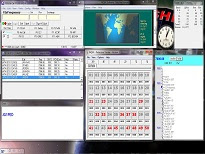in Concord, Ca. (in the SF East Bay). (Last year W6J operated portable from Monterey on the
beach - with a horribly mismatched antenna.)

|
 |
 |
 |

|
 |
While JIDX has become one of my favorite contests, it is also consistently a disappointment in terms of the lower than expected participation from the Japanese themselves. Most of the time it seemed like there were more stateside stations Calling CQ JA, than JA stations calling CQ JIDX.
Eventually, I became one of those statesiders calling CQ JA.
The JIDX contest opened with a rapidly declining solar flux and a K-Index of 3.
Just when it seemed like the K-Index was itself on a decline, a CME hit the ionosphere sending
it back to 3, taking the receive noise-level even higher. 15m and 10 m stayed open here on the west coast until after 05:00z on April 14. Unfortunately, aside from a couple of loud kilowatt JA stations,
the rest of the signals were from Oceania and the South Pacific.
JA activity on 80 & 20 were quite a disappointment. Not surprising, no JA signals were heard on 160. Three years ago (JIDX 2010) 160 had lots of activity; memorable because the Centurion amplifier arced over on 160 (during receive no less) at 10:30z.
Despite my disappointments, the 2013 JIDX contest did give me an opportunity to test-run the latest release of the Prefecture Tracker by WQ6X Software. You can see the mini version of the software
in the 2nd picture (above). This year I expect to release Version 5 of the Prefecture tracker with its considerably more detailed screen, as shown below.
The software can input a Cabrillo .LOG file to produce the stat screen data below.
Notice that we now have the name of each prefecture in the box. An upcoming screen will be designed around a map of Japan with call areas and prefecture #'s - for complete after-contest documentation.
Do you know of ANYONE who managed to work ALL prefectures in a JIDX contest?
I've been close every year, but never made it.
Did you play in the JIDX contest?
If so, how did it turn out?
Curiously,
Ron
WQ6X



